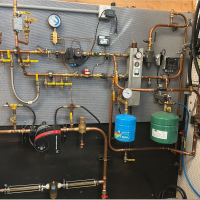Before you swap a component
I find that electrical contacts may oxidize over time, and this can present symptoms like a failing component would. Often, these errors are intermittent. Ignitors, solenoids etc. may present a "low amps" type error, and often end up getting replaced.
I am thinking, that cleaning the contacts should always be an inexpensive first line of defense in such cases. If it does not help, no harm done, if it does, it saves a chunk of money.
I spray some contact cleaner ( e.g. Deoxit) on very fine ( >1000 grit) sandpaper to clean the contacts with. Seems to be common sense, but the typical burner tech or service company may have a "part swap" bias. Is this something you guys tend to always try first?
Caveat: I said contact cleaner. Using dielectric grease is a bad idea.
Comments
-
I have not clean point since the R117…I use to put a coat of pencil ( graphite ) on the point surface . Use to carry replacement clappers on the truck… I am trying to figure which controls today you can clean .. Would it be worth giving it a try today ?
There was an error rendering this rich post.
0 -
-
Service techs in most cases will not clean contacts. You pay for a service call. If they clean contacts and get a call back who pays for the second call?
If you're working on your own equipment that is fine, but contractors will usually not want to do that and will replace the control if it is a simple swap.
Probably the most important issue is to make sure the controls are selected properly so the relays etc have ample capacity for the load they control.
2 -
Deoxit or equal, yes. Spritz. Abrasive? No. Not with plated. It used to be, once upon a time, that one could use a very fine file, but nothing which could leave particles embedded in the surface.
Deoxit is also good on the pins and sockets of connectors or stab connectors.
Dielectric grease is… dielectric. Which means that it is an insulator. Not what you want at all. There are applications for it — but contacts and connectors aren't among them.
Br. Jamie, osb
Building superintendent/caretaker, 7200 sq. ft. historic house museum with dependencies in New England0 -
-
All I am saying, bad or marginal contacts can present like a failing component. I appreciate the service professional's point of view on this, where the "coming on site" minimum charge (times 2) may easily exceed the cost of the part. Chances are, the repair will consist of 2 visits anyway. The first one is to diagnose the issue, then a separate quote for the part and labor to install it, typically after ordering the part.
Part of the diagnostic visit could include cleaning the contacts. At least you could be reasonably sure the part really needs to be replaced if it still fails.If the contact is oxidized (say, on the primary controller) the problem may stick around despite of the part replacement. So cleaning all the contacts when you need to open up the junction box under the primary for any reason may not be a bad idea. Recently I had to replace a Carlin solenoid, and a Carlin 45000 ignitor, both for "low amps" errors. Both were ~3 years old. What led me to think about contacts was that the brand new ignitor was throwing "low amps" errors, just like the old one.
Now I am thinking the "failing solenoid" may have been a contact issue as well, so going forward I will always check/clean the contacts first. Come to think of it, I have a hard time believing that something as simple as a solenoid could fail after just 3 years service.
0 -
As we move more and more to digital control signals, contact points are not such a good way to switch.
Control engineers tell us it is time to move away from AC controls, 24VAC for example, move to DC which has more options for modulating, etc. I noticed this trend at the Bellimo booth this year.
As we started to see failed end switched, the switch manufacturer suggested we did not have enough current draw, switching digital controls, to provide what they call "sealing current" the current draw across the points helps keep a solid contact. Dig deep enough and you find a low end and high end rating on switches.
With their suggestion we switched to reed switches. The closure force is provided by a magnet pulling and sealing the contacts, so they have a very low end rating, unlike the typical micro switch used in zone valves.
Plus a reed switch can be dipped in resin and hermetically sealed, as contaminants from surrounding conditions take out contact points is standard relays and contactors. Sheetrock dust is a switch killer!
However, you give up the high end rating with a reed switch, so they really need to go through a relay box.
There are some micro, contact point, type switches that have a sliding action as they close, to help wipe containments from the contacts. We looked at those as an option, but it still didn't address the low current draw applications.
Bob "hot rod" Rohr
trainer for Caleffi NA
Living the hydronic dream0
Categories
- All Categories
- 87.3K THE MAIN WALL
- 3.2K A-C, Heat Pumps & Refrigeration
- 61 Biomass
- 427 Carbon Monoxide Awareness
- 119 Chimneys & Flues
- 2.1K Domestic Hot Water
- 5.8K Gas Heating
- 114 Geothermal
- 165 Indoor-Air Quality
- 3.7K Oil Heating
- 76 Pipe Deterioration
- 1K Plumbing
- 6.5K Radiant Heating
- 395 Solar
- 15.6K Strictly Steam
- 3.4K Thermostats and Controls
- 56 Water Quality
- 51 Industry Classes
- 50 Job Opportunities
- 18 Recall Announcements





